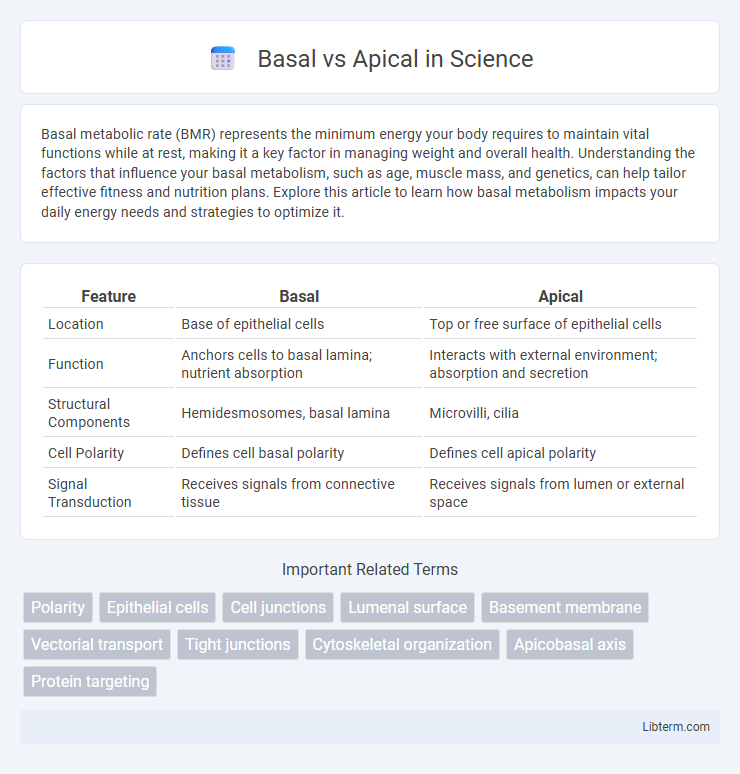Basal metabolic rate (BMR) represents the minimum energy your body requires to maintain vital functions while at rest, making it a key factor in managing weight and overall health. Understanding the factors that influence your basal metabolism, such as age, muscle mass, and genetics, can help tailor effective fitness and nutrition plans. Explore this article to learn how basal metabolism impacts your daily energy needs and strategies to optimize it.
Table of Comparison
| Feature | Basal | Apical |
|---|---|---|
| Location | Base of epithelial cells | Top or free surface of epithelial cells |
| Function | Anchors cells to basal lamina; nutrient absorption | Interacts with external environment; absorption and secretion |
| Structural Components | Hemidesmosomes, basal lamina | Microvilli, cilia |
| Cell Polarity | Defines cell basal polarity | Defines cell apical polarity |
| Signal Transduction | Receives signals from connective tissue | Receives signals from lumen or external space |
Understanding Basal and Apical: Definitions
Basal refers to the base or bottom layer of a structure, often describing cells or tissues positioned closest to the underlying surface, while apical denotes the top or tip layer, typically facing the external environment or lumen. Understanding basal and apical orientations is crucial in cell biology, particularly in epithelial tissues where polarity determines function and nutrient transport. Defining these terms clarifies cellular organization, polarity, and directional processes essential in developmental biology and pathology.
Key Differences Between Basal and Apical
Basal refers to the bottom or base part of a structure, while apical pertains to the top or apex region; these terms are crucial in anatomy, botany, and cellular biology to describe orientation and function. Basal cells or tissues often serve foundational or supportive roles, whereas apical regions are typically involved in growth, signaling, or interaction with the environment. Understanding the key differences between basal and apical locations helps clarify processes such as nutrient transport, cellular differentiation, and organ development.
Cellular Structure: Basal vs Apical Orientation
Basal and apical orientations define cellular polarity critical for function in epithelial cells. The basal surface anchors the cell to the basement membrane, facilitating nutrient exchange and structural support through integrins and hemidesmosomes. The apical surface faces the lumen or external environment, featuring specialized structures such as microvilli or cilia that enhance absorption and sensory functions.
Functional Roles of Basal and Apical Surfaces
Basal and apical surfaces play distinct functional roles in epithelial cells, with the basal surface anchoring the cell to the extracellular matrix through hemidesmosomes, providing structural support and facilitating nutrient absorption. The apical surface faces the lumen or external environment, specialized for absorption, secretion, or sensory reception, often featuring microvilli or cilia to enhance these functions. Together, these surfaces maintain cellular polarity essential for effective tissue organization and physiological processes.
Molecular Markers for Basal and Apical Domains
Basal and apical domains in epithelial cells are distinguished by specific molecular markers that regulate cell polarity and function. Basal domains typically express integrins and laminins, which mediate attachment to the extracellular matrix and basement membrane, while apical domains feature markers such as podocalyxin and ezrin that organize the actin cytoskeleton and form microvilli or cilia. Differential localization of proteins like Par complex (Par3, Par6, aPKC) in the apical domain and Scribble complex in the basal domain is crucial for maintaining cellular architecture and directional signaling.
Importance in Epithelial Tissue Organization
Basal and apical surfaces play critical roles in epithelial tissue organization, with the basal surface anchoring cells to the basement membrane, ensuring structural stability and selective permeability. The apical surface faces the lumen or external environment, facilitating absorption, secretion, and protection. Proper polarity between basal and apical domains is essential for maintaining tissue function, cellular signaling, and barrier integrity in epithelial layers.
Role in Cell Polarity and Signaling
Basal and apical domains define cell polarity by establishing distinct cellular regions crucial for directional signaling and transport functions. The apical surface mediates interactions with the external environment and regulates signal reception, while the basal surface anchors cells to the extracellular matrix, facilitating adhesion and signal transduction pathways essential for tissue organization. This spatial segregation of signaling complexes ensures precise cellular responses and maintains overall tissue homeostasis.
Basal vs Apical in Disease Mechanisms
Basal and apical regions of cells exhibit distinct roles in disease mechanisms, influencing cellular polarity, signaling, and barrier function. Basal defects often disrupt cell adhesion and extracellular matrix interactions, contributing to invasive cancer progression and fibrosis. Apical abnormalities primarily impair nutrient transport and pathogen defense, leading to diseases like cystic fibrosis and chronic respiratory infections.
Implications for Research and Medicine
Basal and apical cellular structures exhibit distinct molecular profiles influencing tissue polarization, which is critical in cancer metastasis research and targeted drug delivery. Understanding the differential protein expression and signaling pathways between basal and apical domains aids in developing precision therapies for epithelial disorders and enhances organ-on-a-chip models for drug screening. Advanced imaging techniques and molecular markers specific to basal and apical surfaces provide crucial insights into epithelial cell function, enabling breakthroughs in regenerative medicine and disease modeling.
Summary and Future Perspectives
Basal and apical cell polarity are fundamental to tissue organization and function, with basal polarity governing cell adhesion and growth regulation, while apical polarity controls cell differentiation and lumen formation. Emerging research highlights the interplay between these polarity domains in disease mechanisms, particularly cancer progression and epithelial disorders. Future perspectives emphasize targeted molecular therapies that modulate polarity proteins and pathways to restore tissue homeostasis and inhibit pathological transformations.
Basal Infographic

 libterm.com
libterm.com